MIT Lesson 4 Kanji: 第4課の漢字
 Each large, brush-stroke
image below which shows up as a hypertext link (e.g. has a colored box
around it) is a link to a 1 Megabyte (or less) QuickTime movie of the
character being painted with a brush. Look
here for information on configuring your browser appropriately.
Each large, brush-stroke
image below which shows up as a hypertext link (e.g. has a colored box
around it) is a link to a 1 Megabyte (or less) QuickTime movie of the
character being painted with a brush. Look
here for information on configuring your browser appropriately.
JP NET is grateful to Prof. Saeko Komori for
permission to use the kanji movies at our site. All movie data is
copyright 1995, 1996 by Saeko Komori.
In the following definitions, on (Chinese-based) readings
are represented by katakana, and by capital romaji letters;
kun (native Japanese-based) readings are represented by
hiragana, and by lower-case romaji letters. This is a common
dictionary convention, and does not have any bearing on meaning.
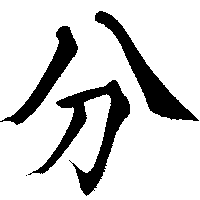
- Printed form:
- 分
- Readings:
- わ(かります) wa(karimasu) - understand
- フン、-プン (hun, -pun) - unit of time/arc
- Mnemonic:
- The number eight 八 and a sword 刀 to represent the
meaning of "to divide". When you understand, it means that
you can see the difference from one to the other.
- Usage Examples:
- 分かります (わかります) (I) understand.
- 一分 (いっぷん) one minute
- 五分 (ごふん) five minutes
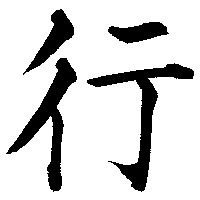
- Printed form:
- 行
- Readings:
- い(きます)
- i(kimasu)
- Meaning:
- to go
- Mnemonic:
- Two persons イ go together.
- Usage Examples:
- 行きます (いきます) (I) will go.
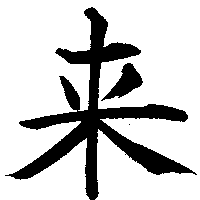
- Printed form:
- 来
- Readings:
- き- / く-
- ki- / ku-
- Meaning:
- to come
- Mnemonic:
- The coming of rice grains 米 is a gift from heaven. The top line
emphasizes the yield.
- Usage Examples:
- 来ません (きません) (I) won't come.
- 来る (くる) to come
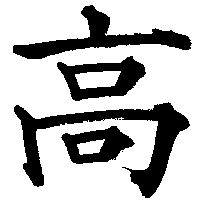
- Printed form:
- 高
- Readings:
- たか-
- taka-
- Meaning:
- expensive; high
- Mnemonic:
- An image of a two-story house.
- Usage Examples:
- 高いです (たかいです) (It) is expensive.
- 高田さん (たかださん) (Mr.) Takada
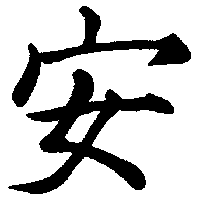
- Printed form:
- 安
- Readings:
- やす-
- yasu-
- Meaning:
- cheap; peaceful
- Mnemonic:
- A woman 女 under a roof ウ(as in 家(house), 室(room),
院(institute)).
She is the one who generates "peace" in the house.
- Usage Examples:
- 安いです (やすいです) (It) is cheap.
- 安田さん (やすださん) (Mr.) Yasuda
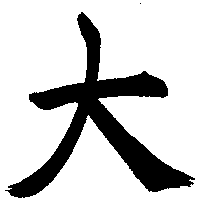
- Printed form:
- 大
- Readings:
- おお-
- oo-
- Meaning:
- big
- Mnemonic:
- An image of a person with arms stretching wide--big, strong person.
- Usage Examples:
- 大きいです (おおきいです) (It) is big.

- Printed form:
- 小
- Readings:
- ちい- (chii-) small
- こ- (ko-) small (prefix)
- Mnemonic:
- An image of a person with arms hanging down - a small, weak person.
- Usage Examples:
- 小さいです (ちいさいです) (It) is small.
- 小山さん (こやまさん) (Mr.) Koyama
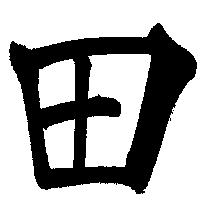
- Printed form:
- 田
- Readings:
- た(-だ)
- ta(da)
- Meaning:
- rice field
- Mnemonic:
- Rice fields in Japan are square and divided by narrow paths.
- Usage Examples:
- 大田さん (おおたさん) (Mr.) Oota
- 小田さん (おださん) (Mr.) Oda
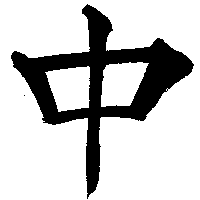
- Printed form:
- 中
- Readings:
- なか (naka) middle; inside
- チュウ (tyuu) middle; China
- Mnemonic:
- An arrow striking through the middle of something.
- Usage Examples:
- 田中さん (たなかさん) (Mr.) Tanaka
- 中田さん (/なかたさん) (Mr.) Nakada/Nakata
- 中山さん (なかやまさん) (Mr.) Nakayama
- 中ごく (ちゅうごく) China
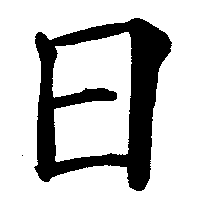
- Printed form:
- 日
- Readings:
- ニチ
- NICHI
- Meaning:
- day; sun
- Mnemonic:
- An image of the sun.
- Usage Examples:
- 日本 (にほん) Japan
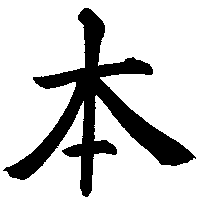
- Printed form:
- 本
- Readings:
- ホン(/ボン/ポン)/もと
- HON(-PON/-BON)/moto
- Meaning:
- origin; book; (classifier of long objects)
- Mnemonic:
- A tree 木 and a short stroke at the buttom representing roots.
A book is a source of knowledge.
- Usage Examples:
- 本 (ほん) book
- 一本 (いっぽん) one (long object)
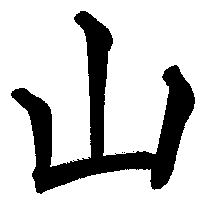
- Printed form:
- 山
- Readings:
- やま
- yama
- Meaning:
- mountain (See also L.15A Photographic Vocabulary Aid)
- Mnemonic:
- Shape of a mountain with three summits.
- Usage Examples:
- 山田さん (やまださん) (Mr.) Yamada
- 山本さん (やまもとさん) (Mr.) Yamamoto
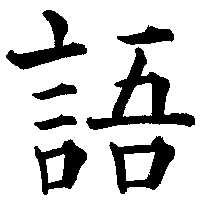
- Printed form:
- 語
- Readings:
- ゴ
- GO
- Meaning:
- language
- Mnemonic:
- The combination of 言(to say), 五(five), and 口(mouth), symbolizing
"many toungues".
- Usage Examples:
- 日本語 (にほんご) Japanese (language)
- ドイツ語 (ドイツご) German (language)
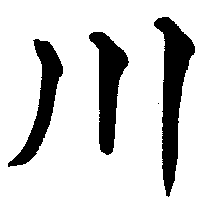
- Printed form:
- 川
- Readings:
- かわ
- kawa
- Meaning:
- river
- Mnemonic:
- The course of river
- Usage Examples:
- 大川さん[おおかわさん] () (Mr.) Ookawa
- 小川さん[おがわさん] () (Mr.) Ogawa
- 川本さん[かわもとさん] () (Mr.) Kawamoto
 Each large, brush-stroke
image below which shows up as a hypertext link (e.g. has a colored box
around it) is a link to a 1 Megabyte (or less) QuickTime movie of the
character being painted with a brush. Look
here for information on configuring your browser appropriately.
Each large, brush-stroke
image below which shows up as a hypertext link (e.g. has a colored box
around it) is a link to a 1 Megabyte (or less) QuickTime movie of the
character being painted with a brush. Look
here for information on configuring your browser appropriately.












